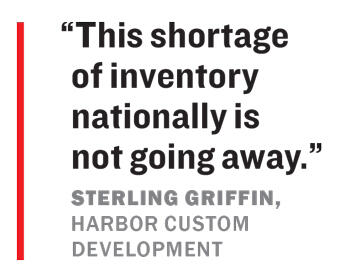Untethered from the daily commute, homebuyers fanned out across the country during the pandemic, seizing their newfound freedom to explore markets far away from city centers.
Harbor Custom Development was ready for them.
“It just pushed everyone to us,” said Sterling Griffin, CEO of the publicly traded homebuilder. “I can’t imagine any better set of circumstances.”
Since forming in 2014, Harbor has focused on suburban markets primarily in areas without a personal income tax. That strategy paid off as the pandemic drove up demand in places already low on inventory. The company recently announced that it’s adding more than 200 single-family homes in the Austin area, where the median sale price rose a shocking 30 percent last year, according to the Austin Board of Realtors.
“That pressure, on a very, very significant shortage of inventory, you are throwing fuel on the fire,” Griffin said.
Austin is not unique, at least in terms of housing supply. Inventory has collapsed in markets across the country. A recent estimate by Realtor.com found that the U.S. is short by more than 5 million homes. The number of homes on the market plunged to a record low of 456,000 in March, according to a report by Redfin, a 50 percent decrease from two years ago.
There isn’t a singular reason for the lack of listings in most markets. When adjusted for population growth, the number of new homes built in the U.S. has consistently declined since the 1980s. Demand that exploded during the pandemic was further exacerbated by rising rents, which created additional competition by luring some would-be tenants into the housing market.
The hot rental sector has also attracted institutional investors, who have spent billions during the pandemic buying up single-family homes in bulk and converting them to rentals, further squeezing supply.
It’s become such a lucrative opportunity that a growing number of new houses are being built specifically to be rented out, bypassing traditional homebuyers entirely. More than 25 percent of houses purchased by rental investors in the fourth quarter was newly constructed, according to data from John Burns Real Estate Consulting, up from 3 percent in the first quarter of 2019.
Meanwhile, once interest rates began rising, some owners who might otherwise have sold opted to keep their homes off the market rather than risk being unable to find a suitable replacement or getting locked into a pricier mortgage.
For a well-positioned homebuilder like Harbor, with access to institutional financing, these conditions can mean higher returns. But smaller developers and contractors can struggle to secure funding as interest rates continue to climb and delays in procuring supplies snarl project timelines.
 These challenges, as well as land use restrictions and the amount of time it takes to develop even in the most ideal of circumstances, make it unlikely that homebuilders will catch up with demand anytime soon.
These challenges, as well as land use restrictions and the amount of time it takes to develop even in the most ideal of circumstances, make it unlikely that homebuilders will catch up with demand anytime soon.
“Housing is a market where supply is very inelastic,” said Benjamin Keys, a real estate and finance professor at the University of Pennsylvania’s Wharton School. “Large price changes do not lead to a large upswing in production in most markets.”
Griffin said that supply chain disruptions are likely to continue to affect home construction over the next year.
“This shortage of inventory nationally is not going away anytime soon,” he said. “How could you create inventory at the scale that is necessary, nationally, to meet demand?”
A long-foreseen crunch
The supply of single-family homes across the country has been on a downward trajectory since the 1980s. Researchers at Freddie Mac estimate that construction was completed on only 65,000 entry-level homes in 2020, less than one-fifth the yearly average in the late 1970s and early 1980s.
Keys said demand has also been fueled by long-anticipated forces, such as millennials, who now make up the largest U.S. demographic at 72 million, reaching buying age or baby boomers buying second homes.
“This was foreseen before Covid, that there would be a demographic sweet spot,” he said.
Demand has shown signs of slackening with homes and mortgages getting more expensive. Existing-home sales dropped for the second straight month in March, according to the National Association of Realtors. But a primary reason is the lack of listings. There remains only two months’ worth of supply; a balanced market typically has six months’ worth.
Steve Dutra, John Burns’ chief information officer, noted that the price cuts observed in some areas largely represent a correction rather than a sign of the market cooling. For that to happen, the volume of listings would need to spike considerably, but he said they remain “really, really low.”
Hesitant sellers
Sky-high home values might seem like an incentive to sell, but brokers say they’re actually preventing homeowners from listing.
“Suddenly, the cost to move got a lot more expensive,” said Rick Sobin, managing partner at @properties’ Chicago Gold Coast and Lincoln Park offices. “It’s making people say, ‘Hey I think I’m going to stay here for a bit longer and see what happens.’”
Sobin said that only 1.5 months’ worth of inventory remains in Chicago, and it’s fallen to just one month’s worth in the suburbs, down from 1.2 a year ago.
Mary Grant, an @properties broker in Winnetka, a suburb north of Chicago, said market conditions are constraining sales, particularly among baby boomers.
“In the past, I represented more sellers. Now I’m definitely representing more buyers,” she said, adding that business for many brokers has slowed recently.

Dutra said sellers are “very cautious.” Roughly half of U.S. homeowners have a mortgage rate that hovers below 4 percent, according to Redfin. With 30-year rates approaching 6 percent as of late April, sellers may opt to maintain their lower rate and stay put.
A similar trend is playing out in Los Angeles, brokers say.
Listings are down 50 percent year-over-year, according to Ivan Estrada, a Beverly Hills-based broker with Douglas Elliman. The lack of inventory has driven prices so high that in some places near Santa Monica, $3 million only gets you a teardown, according to Compass broker Robert Maschio.
Estrada is advising buyers to build rather than pay a premium for a house that may need renovations. An existing home that would sell for $5 million in the current Los Angeles-area market can be built for about $1.5 million, he said. Others are choosing to renovate their homes instead of moving.
“It’s not a stock where you buy low and sell high,” Maschio said. “People have their lives wrapped up in their homes.”
Broadly speaking, Los Angeles’ luxury market is less frantic. Homes asking $4 million or more sit on the market longer and buyers have more negotiating power, according to Estrada.
“It’s getting difficult to live in California, especially if you have wealth. Those people have moved or taken primary residence to Texas, Florida or Arizona,” Estrada said, rattling off three states with considerably lower tax rates for the wealthy.
Red tape
Although building filings for new homes are on the rise, delivering those homes is another matter.
“Homebuilders have gotten the signal that something is out of whack with supply and demand,” Keys said. But shifts in land-use regulations have discouraged more construction.
A 2018 Wharton survey found that across the country, density restrictions such as minimum lot sizes had generally become both more common and more constraining since 2006.
The most restrictive land-use regulations tend to be concentrated on the coasts, the survey found, particularly in and around New York City and the San Francisco Bay Area. Miami and Los Angeles also ranked among the 10 most restrictive metropolitan areas. Not surprisingly, these are among the most expensive housing markets in the U.S.
A controversial proposed tax on house flippers in California could keep even more homes off the market, Estrada said. Profits from flipped houses in the state are already taxed up to 12.3 percent. The proposed California Housing Speculation Act would tack on a 25 percent tax on the capital gains, which for high earners would nearly triple the tax rate on homes sold within three years of purchase.
Estrada said he doesn’t see a way out of the current predicament in Los Angeles without changes to local zoning laws and less red tape for developers.
“L.A. would have to become a much more vertical city,” he said. “It’s all going to come down to local and state government.”

